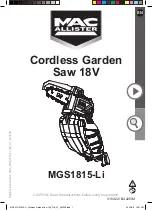
10 ENGLISH
37.
Before using the tool on an actual workpiece,
let it run for a while. Watch for vibration or
wobbling that could indicate poor installation
or a poorly balanced blade.
38.
Wait until the blade attains full speed before
cutting.
39.
Stop operation immediately if you notice any-
thing abnormal.
40.
Do not attempt to lock the trigger in the on
position.
41.
Be alert at all times, especially during repeti-
tive, monotonous operations. Do not be lulled
into a false sense of security. Blades are
extremely unforgiving.
42.
Always use accessories recommended in this
manual. Use of improper accessories such as
abrasive wheels may cause an injury.
43.
Take care when slotting.
44.
Some dust created from operation contains
chemicals known to cause cancer, birth
defects or other reproductive harm. Some
examples of these chemicals are:
•
Lead from lead-based-painted material
and, arsenic and chromium from chemi-
cally-treated lumber.
•
Your risk from these exposures varies,
depending on how often you do this
type of work. To reduce your exposure
to these chemicals: work in a well venti-
lated area and work with approved safety
equipment, such as those dust masks
that are specially designed to filter out
microscopic particles.
45.
To reduce the emitted noise, always be sure
that the blade is sharp and clean.
46.
The operator is adequately trained in the use,
adjustment and operation of the machine.
SAVE THESE INSTRUCTIONS.
WARNING:
DO NOT let comfort or familiarity
with product (gained from repeated use) replace
strict adherence to safety rules for the subject
product. MISUSE or failure to follow the safety
rules stated in this instruction manual may cause
serious personal injury.
INSTALLATION
When the tool is shipped, the handle is locked in the
lowered position by the stopper pin. Loosen the bolt
with a wrench provided with the tool and move the saw
head to the right angle. Remove the bolt and secure the
saw head with the knob.
►
Fig.1:
1.
Wrench
►
Fig.2:
1.
Knob
Installing auxiliary plate
Installing the auxiliary plate using the hole in the tool's
base and secure it by tightening the screw.
►
Fig.3:
1.
Auxiliary plate
2.
Screw
3.
Base
Bench mounting
When the tool is shipped, the handle is locked in the
lowered position by the stopper pin. Release the stop-
per pin by lowering the handle slightly and pulling the
stopper pin.
►
Fig.4:
1.
Stopper pin
This tool should be bolted with four bolts to a level and
stable surface using the bolt holes provided in the tool's
base. This will help prevent tipping and possible injury.
►
Fig.5:
1.
Bolt
FUNCTIONAL
DESCRIPTION
CAUTION:
Always be sure that the tool is
switched off and unplugged before adjusting or
checking function on the tool.
Blade guard
►
Fig.6:
1.
Blade guard
When lowering the handle, the blade guard rises auto-
matically. The guard is spring loaded so it returns to
its original position when the cut is completed and the
handle is raised. NEVER DEFEAT OR REMOVE THE
BLADE GUARD OR THE SPRING WHICH ATTACHES
TO THE GUARD.
In the interest of your personal safety, always maintain
the blade guard in good condition. Any irregular opera-
tion of the blade guard should be corrected immediately.
Check to assure spring loaded return action of guard.
NEVER USE THE TOOL IF THE BLADE GUARD OR
SPRING IS DAMAGED, FAULTY OR REMOVED.
DOING SO IS HIGHLY DANGEROUS AND CAN
CAUSE SERIOUS PERSONAL INJURY.
If the see-through blade guard becomes dirty, or saw-
dust adheres to it in such a way that the blade and/or
workpiece is no longer easily visible, unplug the saw
and clean the guard carefully with a damp cloth. Do not
use solvents or any petroleum-based cleaners on the
plastic guard.
If the blade guard is especially dirty and vision through
the guard is impaired, use the supplied wrench to
loosen the hex bolt holding the center cover. Loosen
the hex bolt by turning it counterclockwise and raise
the blade guard and center cover. With the blade guard
so positioned, cleaning can be more completely and
efficiently accomplished. When cleaning is complete,
reverse procedure above and secure bolt. Do not
remove spring holding blade guard. If guard becomes
discolored through age or UV light exposure, contact
a Makita service center for a new guard. DO NOT
DEFEAT OR REMOVE GUARD.
►
Fig.7:
1.
Blade guard
Содержание M2300
Страница 2: ...1 Fig 1 1 Fig 2 1 2 3 Fig 3 1 Fig 4 1 Fig 5 1 Fig 6 1 Fig 7 1 Fig 8 2 ...
Страница 3: ...1 Fig 9 2 1 3 130mm Fig 10 1 2 Fig 11 1 Fig 12 1 Fig 13 1 2 Fig 14 1 Fig 15 1 2 Fig 16 3 ...
Страница 4: ...1 Fig 17 1 2 Fig 18 1 2 3 4 Fig 19 1 2 3 4 5 6 Fig 20 1 Fig 21 1 Fig 22 1 Fig 23 1 2 Fig 24 4 ...
Страница 7: ...1 Fig 41 1 2 3 Fig 42 1 Fig 43 1 2 Fig 44 Fig 45 1 2 Fig 46 7 ...
Страница 95: ...95 ...











































